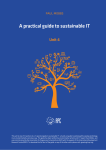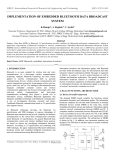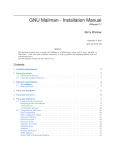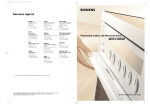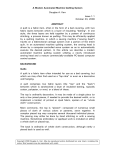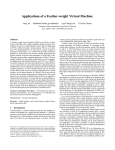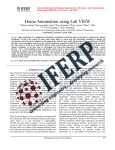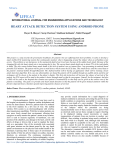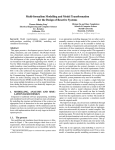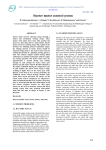Download Strategizing Power Utilization within Intelligent Tags
Transcript
International Journal of P2P Network Trends and Technology (IJPTT) – Volume 9 – June 2014 Strategizing Power Utilization within Intelligent Tags Dr. JKR Sastry1, and Dr. A. Vinya Babu2 1 Department of Computer Science and Engineering, KL University Department of Computer Science and Engineering, JNTU Hyderabad 2 Abstract: Power management within intelligent Tags is one of the most important issues that must be given with utmost importance as the Tags are driven by battery power and the longevity of the battery must be increased so as to reduce the requirement of reducing frequency of charging or replacing the battery. Intelligent tags have many built-in functions that are required for supporting many of the intelligent issues such as identification, locating the tags etc. Each built-in intelligence requires certain amount of power. An event taking place either internally or externally involves usage of a set of intelligent modules which all adds to the requirement of certain amount of power. Power management has a direct impact on the latency with which the intelligent functions can be supported. This paper presents some of the strategies for power saving when a set of relevant functions are to be activated keeping in view of power and latency reduction. Keywords: Power reduction, PSM, CAM, Latency reduction, Intelligent Tag, power saving, Conserving battery discharge, battery saving, battery recharging I. INTRODUCTION Power consumption is one of the limiting factors for any embedded device mainly of those which are battery driven. As the technology advances, the size of the mobile embedded device is minimized for the easy use. So, the size of the battery is being reduced along with other components to reduce the overall size of the embedded device. But, the reduction of size leads to reduction of total charge retained by the battery thereby decreasing its life time. The frequent charging and recharging of the battery is not performed especially when the devices in which the battery is fitted are mobile. However if we succeed in reducing the overall power consumed by the components in the device, the luxury of either reducing the battery size while retaining the original characteristics or increasing the battery lifetime while retaining the original size or combination of both can be achieved. The power consumption in the embedded device depends on the power required and consumed by the various components in it. The battery lifetime can be prolonged by decreasing the power consumed by the components. Several available power management techniques provide the required power reduction in embedded devices. Battery charge can be preserved through various methods like allowing the central processing unit (CPU) to slow down, suspend or shut down part or all of the system. Tags generally consist of many modules which are integrated. Not all the modules will be active all the time. The unused modules can be shut-down or sent to sleep mode. ISSN: 2249-2615 Different challenges like software optimization, low power communication, low power display and low power data management and fault tolerance should be considered to increase the longevity of the battery. Power management policies can be described at various levels of abstraction starting from the lowest level transistor to the final application level. The different levels of abstraction include transistor level, architectural level, system level and the application level. The application is usually responsible for the power management as the power consumed depends on various running states of the components of application. Power is required for driving any of the hardware. The embedded software can be used to analyze and improve the power characteristics of the system. Real time operating system (RTOS) generally provides system functions with which the power availability to various parts of the systems can be managed. The user application will be able to recognize the current battery status by invoking related functions supported by RTOS. Once the power requirements of the components are known, the user application should be able to bring the requirement of the power to the lowest level. The system should be able to perform the required operation without losing its efficiency. The efficient power states can be achieved by allowing several components or the combination of the components to be inactive or in sleep mode when the same are not required functionally. Power management does not reduce the performance of the system but simply add features to reduce the power consumption. The low power or sleep modes helps to prolong the life of batteries. Disabling power to one device should not affect any other device. Displays in mobile devices can be power managed by dimming or blanking of displays by cutting power to those devices in idle mode. Device entering to low power mode is generally controlled by timers and switching back to full power mode is done by triggering which is either done manually or automatic. Power is required to drive the hardware and execute software. The most important areas of an Embedded System implementation that are quite related to more power consumption include areas such as display, wireless peripherals, code execution and memory. It is necessary to provide the mechanisms to determine the power requirements of the components in the system and to provide the power management techniques to manage the overall power of the system to the lowest level thereby increasing the life of the battery. http://www.ijpttjournal.org Page 1 International Journal of P2P Network Trends and Technology (IJPTT) – Volume 9 – June 2014 Intelligence has to be added for efficient power management within the Tags. The addition of intelligence to the Tags is important from the point of view of longevity of battery as much as possible considering that the intelligent Tags are remotely situated and that the intelligent TAG must support many number of functional modules which works in conjunction with embedded hardware. used can be placed in low power states. This reduces the power consumption. The relationship and interactions between system, application and device power managers with each other using UML class diagrams, sequence diagrams and state charts are proposed. This object oriented approach make the embedded system more efficient, easy to maintain and faster to develop. Following are some of the major issues that affect the power of the TAG. A power management system [3] has been included into cinder operating system. The feature that is related to controlling power through proper allocation is useful and important to be included into the operating systems that are used in mobile devices. A reserve is a mechanism for resource delegation, providing fine-grained accounting and acting as an allotment from which applications draw resources. “Cinder” estimates energy consumption using standard device-level accounting and modeling. Their research findings have been proposed which includes an operating system that implements “reserves and taps” as new mechanisms for managing and controlling energy consumption, evaluating the effectiveness and power of these mechanisms in a variety of realistic and complex application scenarios running on a real mobile phone and experiences in writing a mobile phone operating system, outlining the challenges and impediments faced when conducting systems research on the dominant end-user computing platform. Choice of appropriate power management system that help lowering the power of a TAG when several modules are integrated in the TAG. A TAG with high longevity of the battery. Implementing challenges like low communication, low power display etc. To manage power without losing efficiency of an embedded systems. power Thus the problem is to determine the power requirements of the components in the system and to determine various power reduction strategies and power management techniques to manage the overall power of the system to the lowest level thereby increasing the life of the battery while at the same time maintaining efficiency. II. RELATED WORK An enhanced RFID technology [1] provides various functionalities like high operating range and sensing and monitoring capabilities. These functionalities require data acquisition units, real time clocks and active transmitters which in turn cause a high power consumption of the TAG. Several power management techniques for battery driven Tags supported by energy harvesting devices are proposed. Sleep transition protocol and wakeup control protocol is the power saving strategy where system is in power saving state as long as possible. The TAG stays in sleep mode and shifts to the active mode when triggered by a certain event. The additional power can be provided by energy harvesting devices which converts the energy from environment into electrical energy. The lifetime of the battery can be increased. The common energy sources are mechanical energy (vibrations-piezo generator), solar light (solar cells), thermal energy (thermo generator) and some less common sources like electromagnetic energy. This generated power requires special storage and buffer structures. The two types of storage devices are primary storage and secondary storage. The primary devices are not rechargeable and secondary devices are rechargeable. An abstract model of a system power manager (PM), device power manager and application power managers has been proposed [2]. Power management in embedded devices can be developed for real time operating systems or its applications. If power management techniques are present in embedded devices, the features and components which are not being ISSN: 2249-2615 WLAN power conservation technologies have been in use these days [4].. The power save mode is just one of a range of options. Constantly awake (CAM) is one of the techniques which are widely used today where the power saving features is disabled due to reduction in performance in terms of throughput when power saving measures is enabled. Power save mode (PSM) is the method in which the mobile device is switched off after a prefixed length of time. The device is wakeup periodically for any data. Unscheduled automatic power save delivery (U-APSD) is the method where the client is allowed to access the data without waiting for the next beacon. This technique is efficient in case of lighter traffic loads. Power save multi poll (PSMP) is used for multiple radios. The WI-FI adapter intimates the access point that it was powered down. The access stores the data received by it and returns it to the adapter only when it is turned on again. However it increases latency and traffic when it is turned on. Wi-Fi power saving mode radios consumes power for both transmitting and receiving [5]. A typical laptop Wi-Fi radio may consume a few watts while in use. There are several tricks and tweaks you can perform to reduce the power consumption, even when you are using Wi-Fi all the time. Because of the power requirements for Wi-Fi, the Power Save Poll protocol (PS-Poll) was developed to help reduce the amount of time a radio needs to be powered. Rather than having the radio all the time, PS-Poll allows the Wi-Fi adapter to notify the access point when it will be powered down. While the radio is powered down, the access point will hold any network packets which would need to be sent to it. Of course, the longer the radio is off, the more power you save. Device Drivers can control time elapses before the radio is http://www.ijpttjournal.org Page 2 International Journal of P2P Network Trends and Technology (IJPTT) – Volume 9 – June 2014 turned on again, to get the pending packets from the access point. Conservation of battery power is important for low TAG maintenance [6]. The energy saving mechanism on the active Tags is proposed which is referred as smart buffer. It consists of circuit fabricated in silicon that looks at the destination of each packet of ISO standard and produces a wake up signal. The smart buffer requires considerably less power than is required by the TAG to interrogate the same message to determine the target destination. This invention presents a model tracking the energy used by a set of Tags. It provides a basis to investigate and determine the conditions that must be met for the smart buffer equipped TAG to produce a net energy savings. Software level methods for optimizing the power in wireless embedded devices have been proposed [7[. Power consumption in wireless devices is an important concern in such devices. Power optimization can be done either by changes in hardware or software. Generally hardware is fixed by the vendor and cannot be modified by the user. The software level changes can be performed by the user according to the requirements. The loop optimization methods were used and tested to reduce the power consumption to some extent. Similarly unrolling and loop alignment were used to increase the performance in terms of power. The software level methods like nested switches, no of parameters, no of local variables, data type are proposed which improves the power consumption of the coding. Power management technique for location estimation have been proposed [8]. The algorithm is used in two forms. One form is used to locate to locate a device in a single and when the device falls at the intersection of two or more terrains. Location of the handheld device is used as a parameter for cluster calculation. The location estimation is done by triangulation method. The algorithm uses the information about the terrain obtained through google maps. The information is subjected to Signal to Noise Ratio (SNR), phenomenon of reflection, diffraction and scattering and the power required by the portable device for effecting the communication with the tower is calculated. Calculation of the location is based on the available signal strength (ASS) and the receive signal strength (RSS). They have considered GSM architecture and the cell phone for operating as a portable device. The algorithm takes into account that when a device is not participating in the communication, it is directed to change its state from the active mode to a park mode, so the device will save the battery power. Proposed technique falls in the Dynamic Power Management (DPM) category as it is dealing with the battery power during run time. Power optimization for secured Bluetooth based communication has been proposed [9]. Bluetooth technology is capable of providing many services like high data throughput, adhoc networks providing excellent data transmission and many other services in various applications. Power consumption is high compared to other mobile devices ISSN: 2249-2615 due to continuous monitoring. As the device is small and high throughput, there is a need for power optimized algorithm which allows high throughput with less power consumption. The power consumption in Bluetooth can be reduced to a certain level using four operational modes. They are active, sniff, hold and park modes. The battery lifetime can be increased through these modes. [10] proposed a power management technique for location estimation. Power management techniques in embedded devices can be developed as a part of real time operating systems or its applications. If power management techniques are present in embedded devices, the features and components which are not being used can be placed in low power states. This reduces the power consumption. While a device is not participating in the communication, it is directed to change its state from the active mode to a park mode, so the device will save the battery power. The technique recommended by them falls in the category of Dynamic Power Management (DPM) as it is dealing with the battery power during run time. Dynamic voltage scaling (DVS) [11] is one of the techniques in reducing the power dissipation by lowering the supply voltage and operating frequency. Real-time DVS algorithms are presented to provide power savings while maintaining real-time issues. Power consumption in Bluetooth is high compared to other mobile devices due to continuous monitoring. As the device is small and need to support high throughput, there is a need for power optimization which allows for high throughput with less power consumption. Different challenges such as, software optimization, low power communication, low power display and low power data management and fault tolerance in addition to other saving techniques using which the longevity of the battery could be increased have been addressed [12]. A combination of techniques has been used in the intelligent TAG to increase longevity of the battery. Dynamic voltage and frequency scaling (DVFS), Dynamic power management, utilization of various powers saving modes, usage of various power saving protocols etc. The combination of various power management techniques provide an efficient mechanism to reduce the overall power consumption of the intelligent TAG. A software architecture for development of an embedded application which helps in conserving the power consumption and extending the longevity of the battery has been presented [13]. III. POWER MANAGEMENT STRATEGIES Power is required for processors, peripheral devices, and Built-in devices within the micro controller. The micro controllers are designed to operating in various power saving modes which include switching the power to micro controller and restarting the microprocessor using a restart mechanism, switching the power to microprocessor and switching on the power to the microprocessor and switching on the power when an interrupt is initiated by the peripheral and switch on and off the power to the peripherals by the user application. In http://www.ijpttjournal.org Page 3 International Journal of P2P Network Trends and Technology (IJPTT) – Volume 9 – June 2014 the case intelligent systems power to the micro controller is not switched off. The method of switching on and off the power to the peripheral can be controlled through the power management system (PMS) which is one of the modules to be inbuilt into the intelligent Tag. The PMS will switch on the power to peripheral device when its related interrupt has been received by the microcontroller. The I/O is undertaken after the I/O device is powered on and the power to the peripheral device is switched off after the it’s related I/O is completed. Intelligent Tags have to communicate with the remote mobile devices continuously in communicate with it every time information related to identification, change of location, tampering, power depletion taking place below the safety levels using with Wi-Fi or Bluetooth interface. The use of either Wi-Fi or Bluetooth is arbitrated as when the restart of the intelligent tag takes place and based on the arbitration results one of the communication device is chosen and the power to the other deice is switched off. Constant awake protocols are to be used to keep the make the chosen communication device awake. The response time required in case of each of the event taking place in relation to an intelligent feature is different. The identification and change of location can be communicated at higher level of latency whereas the communication related to Power depletion, tampering, alerting must be undertaken with least latency so that the required corrective action is undertaken with no damage caused to the intelligent system. The latency is however is dependent on the way an application system is designed considering the interrupt routine and the way the signaling is to the concerned tasks is implemented. frequency can be changed dynamically by implements the dynamic frequency management system (DFS). The CAM protocol can also decide the powering on or offing the communication devices based on whether there is anything that must be communicated which is actually dependent on the type of event taking place. The various strategies that can be adapted and their related latencies that can be achieved are shown in the Table I. a combination of strategies that can be applied can be predefined relating to implementation of a particular intelligence issue and the same can be implemented through a power management system (PMS) which works as an additional module within the embedded system. The mapping of power management strategies to different intelligent issues has also been shown in Table I. The power management system can select one of these strategies based on the events that take place at any point in time. IV. EXPERIMENTATION The proposed system for tag power management is implemented through embedded C under integrated KEIL development tool kit. Figure I demonstrate that Bluetooth and GPS are interfaced to UART0 and UART1 respectively. Initially the processor and the peripherals will be in sleep mode. A different storage can also be implemented that implements the reduction in power supplied to the peripheral devices which are connected with the events that can be processed at acceptable high level latencies. The devices that are related to intelligent issues that can be undertaken at acceptable high level latencies can be fed with suitable low level voltages and the devices that are related to intelligent issues that are to be undertaken at low level acceptable latencies are to be fed with high level voltages. The system of dynamically controlling the power supply to peripheral devices is called as Dynamic voltage management system (DVS). The power to be fed to wireless communication devices is also dependent on the distances to which communication must be undertaken with the hand held device. The constantly awake protocol (CAM) determines the distances to which communication must be undertaken and therefore fixes the frequency required for effecting the communication. The ISSN: 2249-2615 Figure I: Experimental Setup for Power Management The sleep mode of the tag is notified to the local user through LCD and remote HOST through message displayed on mobile as shown in the figure II. http://www.ijpttjournal.org Page 4 International Journal of P2P Network Trends and Technology (IJPTT) – Volume 9 – June 2014 V. CONCLUSIONS Power management in intelligent TAG is one of the important issues as different technologies must be integrated efficiently with minimum power consumption to increase the longevity of the battery. Intelligent Tags must be in communication with the HOST by using any of the protocols that are supported on the TAG and the HOST. Figure II: Message "Sleep Mode" displayed on LCD and mobile phone Upon occurrence of any event a power management strategy is decided and devices that are required to process the event are made to be in active mode. The power status of the tag is displayed on LCD and is notified to the HOST through message as shown in figure III. The power characteristics of a device are very much dependent on the type of communication standard used for effecting the communication. Selection of a particular communication method has a definite bearing on the power consumption of the device. Several power reduction mechanisms have been presented that are suitable for powering a combination of circuits related to a set of features that are needed to be supported at a time. REFERENCES [1]. [2]. [3]. [4]. [5]. [6]. [7]. [8]. Figure III: Message "Normal Mode" Displayed on LCD and Mobile Phone [9]. The power consumptions by various devices from time to time have been recorded as they are displayed on the LCD and the messages that have been transmitted to the remote HOST also have been displayed on the LCD and the same are recorded. The rate of discharge of battery is decreasing as the time of usage of the TAG is increasing. This is because of efficient power management of the devices and routing every operation to the devices through power management module. The experimental results as recorded are shown in the Table II. It can be seen form the table that a saving of more than 50% in power consumption is achieved by adapting proper power saving strategy and thereby increasing the life of the battery to double the time. The actual saving however be dependent on the frequency of occurrence of the individual events of different types. [10]. ISSN: 2249-2615 [11]. [12]. [13]. Alex Janek, Christian Steger1, Josef Preishuber-Pfluegl2 and Markus Pistauer2, 2007, "Lifetime Extension of Higher Class UHF RFID Tags using special Power Management Techniques and Energy Harvesting Devices", Dagstuhl Seminar Proceedings Ankur Agarwal, Eduardo Fernandez, 2009, "System Level Power Management for Embedded RTOS: An Object Oriented Approach", International Journal of Engineering (IJE),. Vol. 3, Iss. 4, Pg. 12-19 Arjun Roy, Stephen M. Rumble, Ryan Stutsman, Philip Levis, David Mazi`eres, Nickolai Zeldovich, 2011, "Energy Management in mobile devices with cinder operating system" ACM Proceedings, Craig Mathias, 2008, "A guide to Wi-Fi power-save technologies", http://www.networkworld.com/research/2008/051208-wirelesspower-standards.html, lesswatts.org, 2009, "Power reduction in wireless devices", http://www.lesswatts.org/tips/wireless.php, ibridgenetwork.org, 2007, active-rfid-tag-power-optimizationarchitecture, Kavita Deshmukh, Deepshikha Patel, Nitesh Gupta, Shiv Kumar, 2011, "Efficient Coding Mechanism for Low Power Consumption in Wireless Programmable Devices", International Journal of Soft Computing and Engineering (IJSCE), Vol. 2, Iss. 4, Pg. 45-54 Muhammad. A, Mazliham M.S, Shahrulniza.M, 2009, "Power Management for Portable Devices by using Clutter Based Information", IJCSNS International Journal of Computer Science and Network Security, Vol. 9 Iss. 4, Pg. 33-43 Marium Jalal Chaudhry, Sadia Murawwat, Farhat Saleemi, Sadaf Tariq, Maria Saleemi, Fatima Jalal Chaudhry, 2008, "Real-Time Dynamic Voltage Scaling for Low-Power Embedded Operating Systems" Power optimized Bluetooth communication”, IEEE, Padmanabhan Pillai and Kang G. Shin, 2001, "Real-Time Dynamic Voltage Scaling for Low-Power Embedded Operating Systems", U.S. Air force Office of Scientific Research, Xavier P´erez-Costa and Daniel Camps-Mur, 2007, "A Protocol Enhancement for IEEE 802.11 Distributed Power Saving Mechanisms", Volume 1- : LPC214x User Manual, JKR Sastry, N. Venkatram, R. Deepika, LSS Reddy, 2012-7, "Efficient power management techniques for increasing the longevity of intelligent tags", International Transactions on Electrical, Electronics and Communication Engineering Vol. 2 Iss. 2, Pg. 21-25 JKR Sastry JKR, R.Deepika, 2012-8, "Software Architecture for implementing efficient power management techniques within Intelligent TAGS", International journal of Computing, Vol. 2 Iss. 3, Pg. 573-579 http://www.ijpttjournal.org Page 5 International Journal of P2P Network Trends and Technology (IJPTT) – Volume 9 – June 2014 5. 6. 7. Alerting 4. Power depletion 3. Tampering 2. Location identification Power Saving Mode (Power of I/O devices and power on the I/O devices when the Interrupt from the peripheral device is received Dynamic power Management (DVS) through High voltage regulation Dynamic power Management (DVS) through low voltage regulation Dynamic power Management (DFS) through High Frequency regulation Dynamic power Management (DFS) through low frequency regulation Implementing constant awake protocol (powering on and off the wireless communication devices Task Prioritization Tag identification Power Management strategy 1. Influencing Latency Power Saving strategy serial Table I. Power Saving Strategies √ √ X X X X X √ √ √ √ √ X X X X X √ √ √ √ √ X X X √ HIGH √ HIGH √ LOW √ LOW √ LOW √ HIGH √ HIGH √ LOW √ LOW √ LOW High Low HIGH Low HIGH Low/High/ Average Low/High/ Average Table II: Experimental Results for Power Management in Intelligent Tag Power Consumed in Millie Watts Event Total power consumed In Mille Watts Total power required if all the devices are working in Millie watts Saving in power In Millie watts ARM7 Wi-Fi Bluetooth GPS Pressure Sensor Beeper Identification 2.400 1.440 0.000 0.000 0.000 0.240 6.240 11.619 5.379 Location Indemnification 2.328 0.0 0.717 2.156 0.000 0.237 5.438 11.619 6.181 Tampering 2.302 1.421 0.000 0.00 0.235 0.234 4.190 11.619 7.429 Alerting 2.209 1.417 0.000 2.138 0.233 0.232 6.229 11.619 5.319 Power depletion 2.195 0.00 0.702 0.00 0.00 0.230 3.127 11.619 8.419 25.224 58.095 32.817 Total ISSN: 2249-2615 http://www.ijpttjournal.org Page 6






